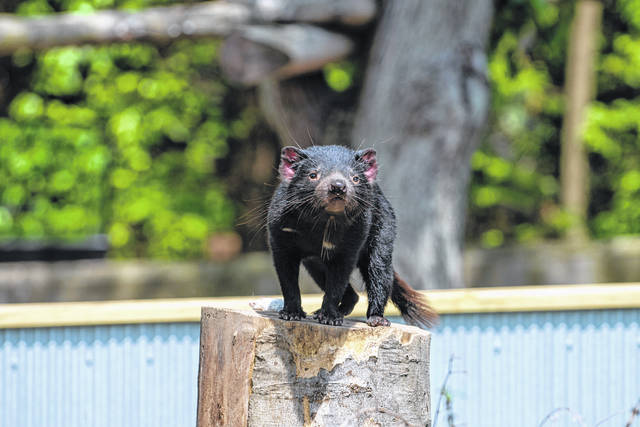
The Columbus Zoo and Aquarium is proud to welcome three Tasmanian devils to the Zoo – the first time the species has been introduced at the Columbus Zoo in over 20 years.
One-year-old Tasmanian devils, Sprout, Thyme and Mustard, arrived in Columbus last week from Tasmania, Australia, accompanied by David Schaap, the Save the Tasmanian Devil Program’s Tasmanian Devil Ambassador Program coordinator. The Columbus Zoo is now one of only seven zoos in North America to currently house the species.
Males, Mustard and Sprout, and Sprout’s sister, Thyme, are still in arrival quarantine per standard protocol, and are transitioning to their brand-new habitat located in the zoo’s Australia and the Islands region. A regular schedule for public viewing has not yet been set but will be announced in the coming days as soon as the Tasmanian devils settle in to their new home.
The Tasmanian devils were brought to the Columbus Zoo and Aquarium through the Save the Tasmanian Devil Program (STDP). This program is the official response by the Tasmanian government to the threat of extinction of the Tasmanian devil due to the Devil Facial Tumour Disease (DFTD). DFTD is a fatal condition in Tasmanian devils characterized by the appearance of obvious facial tumors and is highly contagious among Tasmanian devil populations.
The vision for STDP is for an enduring and ecologically functional population of Tasmanian devils in the wild in Tasmania. STDP’s Ambassador Program was designed with the aim of placing suitable Tasmanian devils into world-class zoos as ambassadors for the species.
DFTD is one of the major conservation threats facing these endangered animals in their native range. Another primary threat that Tasmanian devils face is road kill. Tasmanian devils play a vital role in the ecosystems in which they inhabit as “nature’s auditor,” meaning that they “remove” sick, slow, diseased and deceased animals from the landscape. They also serve as an important line of defense against invasive species, including feral cats. A rapid decline of this species in their native range will have a noticeable impact on the ecology of the landscape and lifecycles of Tasmania flora and fauna.
Over the last five years alone, the Columbus Zoo and Aquarium has supported conservation projects that benefit Tasmanian devils in a variety of ways. These projects include: aiming to develop effective strategies to rebuild wild populations of the Tasmanian devil through the understanding of demographic and genetic effects of the long term presence of DFTD in wild populations and to assess the ecological impacts of a reduced devil population on other wildlife in the north-east coastal plains area; satellite tracking translocated Tasmanian devils; and the genetic analysis of Tasmanian devils (to look for signs of DFTD) from the south-west coast.
“The Tasmanian devils are an exciting addition to our Columbus Zoo family and play an incredibly important role as ambassadors for their species,” said Columbus Zoo President and CEO Tom Stalf. “It is a privilege to be able to work with the Save the Tasmanian Devil Program and continue to expand our impact internationally by contributing to the conservation of this species while also raising awareness within our own community about these animals and how we can help them.”
Schaap added, “The Save the Tasmanian Devil Program is proud to welcome the Columbus Zoo and Aquarium as a partner in the conservation of our iconic species. Through the Tasmanian Devil Ambassador Program, we recognize the enormous impact that the Columbus Zoo can achieve with education on the plight of Tasmanian devils as well as the contributions already made towards the safe-guarding of the species in the wild. Modern zoos are now centers of excellence in conservation and the Columbus Zoo demonstrates this in all of their actions.”
Tasmanian devils (Sarcophilus harrisii) are the world’s largest carnivorous marsupial and live from the coastal plains to the mountains of Tasmania, an island state of Australia. Relative to body size, Tasmanian devils have an even stronger bite than a Bengal tiger, which helps them crush bone and tear the flesh of their prey. They can eat up to 40 percent of their body weight in one sitting.
Dr. David ‘Doozie’ Pemberton, Save the Tasmanian Devil Program manager, said, “It is true to say that devils that are not killed by anthropogenic mortality such as road kill, are at risk of dying a hideous death from this contagious cancer. We are excited to welcome the Columbus Zoo to the Tasmanian Devil Ambassador Program and look forward to furthering the partnership.”
For more information about when the Tasmanian devils will have access to their new habitat, follow the Zoo on Facebook, Twitter and Instagram or visit the Zoo’s website.


